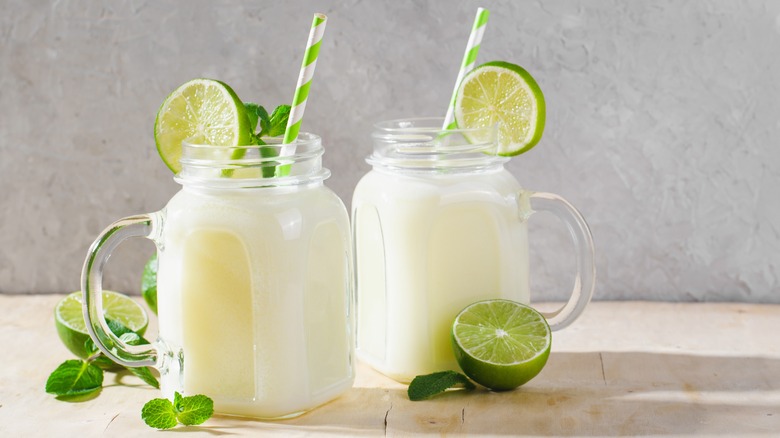What Is Brazilian Lemonade, Anyway?
When you're searching for a refreshing summer drink to cool off with, one of the first things that comes to mind for many is a glass of ice-cold, classic lemonade. Finding a recipe with the perfect balance of tart acidity and sweetness is a work of flavor magic. That said, out of all of the things you should be adding to your lemonade, the creamy addition of condensed milk is a real game-changer. Condensed milk is the star ingredient featured in Brazilian lemonade, which you may be familiar with already if you've ever dined at a Brazilian restaurant. Blending a small can of condensed milk into the drink adds a pleasant layer of richness to the tasting experience without giving the finished product a heavy, milkshake-like consistency.
Maybe you're someone who frequents the Chick-fil-A drive-thru to grab an ice cream-infused Frosted Lemonade, or perhaps you prefer to follow a copycat lemonade recipe at home. Either way, Brazilian lemonade is something to put on your culinary radar. This beverage can even be upgraded to a boozy version with a splash of liquor like rum.
Please note: There is one important distinction to make with this South American specialty that can be a bit confusing at first. Given its title, you would probably think lemons would be involved somewhere, but Brazilian lemonade relies on limes for its signature sharp taste instead.
Why Brazilian lemonade uses limes
Firstly, it's important to know that Brazilian lemonade goes by many names. Locals call it "limonada Suíça," which means "Swiss lemonade." This name is inspired by one of the Swiss-founded Nestlé company's staple products, condensed milk, which the company began selling in the 1940s. The Swiss reference can be a source of confusion when it comes to this beverage, along with its local title — "limonada Suíça" — which contains the Portuguese word for lemonade. Since "limão" is the term used for limes in Portuguese, "limonada" is simply used as an umbrella term for both lime and lemon juices in Brazil.
So, why limes over lemons? Freshly squeezed limes lend a bold citrus zing to Brazilian lemonade, and they have a slightly less sweet, slightly tarter flavor than lemons, along with a thinner rind for easy blending. That bright green rind also adds a vibrant color to the final product. Lemons are surprisingly rare in Brazil, but limes grow abundantly in subtropical places like Brazil — which, together with Mexico, produces around 40% of the world's supply.
You can find Brazilian lemonade on the menus of local chains like the Tucanos Brazilian Grill in the western U.S. and at larger international chains like Fogo de Chão Brazilian Grill. If you're a lemonade lover, give this one a try!

